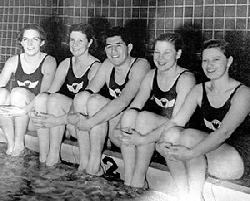|
||||
|
History: Water contests attracted crowds to lake
4/28/2014 12:48:34 PM
By Ross Schneidmiller
Liberty lake Historical Society
Reaching out and touching the slippery log first, Frank Kelly won the race. Swimming 215 yards between wharfs, Kelly narrowly beat out Frank Howard for top honors. Kelly would now hold the prize, a silver cup, against all comers for a period of five weeks. The person who would win the greatest number of times out of the six Sunday contests would keep the cup on which the winner's name would be inscribed.
Roderick MacKenzie, the popular landlord of the MacKenzie Hotel located on Liberty Lake's west side, hosted these types of weekly water competitions in the late 1890s. The lake was in its beginning stages of becoming a popular Spokane destination. MacKenzie utilized the Spokane Daily Chronicle to promote the races and his resort.
Along with swimming events for both youth and adults, there were rowboat races. The largest cash prize offered for the events was for the ladies' rowboat race held on Aug. 1st, 1897. Most of that money stayed in the family, though, since MacKenzie's daughter Carrie won that event, receiving $2 of the $3 purse.
These were not the first races held at the lake, but possibly the first in the resort era. There were competitions during the gatherings that Chief Andrew Seltice of the Coeur d'Alene Indian tribe held at Liberty Lake in the 1850s. A popular event that both the young and middle-aged participated in was the tip-a-canoe races. The canoe that was tipped under water, over and over, the most times in five minutes was proclaimed the winner.
Water competitions became more prevalent as the resort community developed. In 1908 a 350-foot swimming pier was constructed at Liberty Lake Park. It was said to be the most complete in the Pacific Northwest, fitted with gymnastic apparatus including rings and springboards. It also had graduated diving platforms five feet apart up to 30 feet high. A Spokane gym owner was brought in to establish an aquatics program. Van Cook of Cook's Gymnasium held water carnivals on the weekends which included swimming races, canoe races and tilting contests. He also organized water basketball games at the resort between his gym's team and one he assembled at the lake.
It became common to see headlines in the local papers announcing aquatic events or the results of the competitions at the lake, which were often called water, aquatic or sports carnivals. The sophistication in which the races were run grew as the sports of swimming and diving developed. Often someone from the YMCA or YWCA was in charge of the activities. There were classifications for all ages: boys and girls, men and women. The top swimmers and divers from the Inland Empire would compete in these events.
There were rowboat and canoe races as well as novelty events like the single oar race and the coconut race. In the latter, a sack of coconuts was dropped into the lake well out from shore, and the entrants in the event swam out and brought back in as many as possible in one attempt. The crazy man swim was also popular. In this event the participants were required to undress to their bathing suits on the beach, swim around a boat in the lake, return and don their clothes again. This was quite the effort as the required outer garments were shoes, hose, trousers, shirt, tie and knot. Another common event was the tub race; anyone with a washbasin tub could enter.
In the early years the last feature for the water carnivals were the launch races. The entrants were made up of the resort touring boats and resident-owned launches. The race was handicapped to allow for a fair but competitive race. The handicap allowed race officials to compensate for fast or slow boats in the final results and to award the race to the boat with the highest achievement rather than the quickest time. As motorboats increased in speed and racing became more organized and popular, they became events unto themselves attracting thousands of spectators to the lake.
The most impressive water carnival held at the lake was a three-day event in June of 1934. This water show was a combination of events. Liberty Lake Park (renamed Silver City at that time) hosted the Inland Empire Pacific Northwest Amateur Swimming and Diving Championships. Swimming luminaries from Seattle's Washington Athletic Club (W.A.C.) were also on hand for match races plus races against time in their attempts to set American and world records. Seating arrangements were prepared for 6,000 spectators, and bus service was arranged from Spokane.
The first night opened with exhibition swims by coach Ray Daughters' visiting stars from W.A.C., as well as diving demonstrations, spectacular tied board riding, log rolling and other stunts. The second night featured record attempts by Jack Medica, Seattle's world champion. Another highlight was a match race between Olive McKean, national 100-yard champion, and Liberty Lake's very own Mary Lou Petty seeking a new 220-yard record. Petty, who was now training under Daughters, was a big reason the coach hoped to repeat as national relay champions. Record quests by the W.A.C. women's relay team rounded out the evening. Sunday saw additional attempts at world and American marks as well as a five-mile marathon swim by local stars over a triangular course in front of grandstands.
On the Monday after the event, the Chronicle's headlines read, "Water Pageant Is Great Show." Although the crowds were not as large as promoters had hoped, those who did attend witnessed record-smashing accomplishments. Of the records that were broken, some had been held by Olympic swimming legends Helene Madison, Johnny Weissmuller and Buster Crabbe.
Ross Schneidmiller is president of the Liberty Lake Historical Society and a lifetime resident of Liberty Lake.
• • •
Did you know?
• Prizes for the boys rowboat race held at Liberty Lake on Aug. 1, 1897, were 73 cents for first place, 37 cents for second place and a pound of candy for third place.
• The July 30, 1904, edition of The Spokesman-Review credited 22-year-old Joseph Leahy with setting a new swimming record at Liberty Lake. Using mostly the breaststroke, Leahy swam the 1 3/4 mile course across the widest part of the lake in one hour and three minutes. An Irish immigrant, Leahy developed his skills swimming across the two-mile bay of Cork, Ireland.
• A tied board was similar to a rectangle-shaped surfboard except it was tied to the boat by a rope thus freeing up the performer's hands for acrobatics. A board not connected to the boat was called a free board.
• Mary Lou Petty may have lost the match to Olive McKean, but she broke individual swimming records including the 400-meter freestyle record held by McKean. Between 1934 and 1936, Petty set six American records and one world record. As a member of the W.A.C. relay team, she was part of seven American records. In 1936 Petty was the highpoint winner on her 21st birthday at the indoor national swimming meet in Chicago. Later that year she placed 4th in the 400-meter freestyle at the Olympic Games in Berlin, Germany.
• Ray Daughters brought five tested stopwatches with him to Liberty Lake in 1934 so when the timers caught his swimmers breaking records, the new marks would be official.
Events, Competitions and Activities
From the Liberty Lake Historical Society, a 2014 monthly series
January - Ice Skating
February - Parade of Mermaid Competitions
March - Opening Day of Fishing
April - Dancing
May - Water Competitions
June - Liberty Lake Amateur
July - All Valley Picnics
August - Dutch Jake Picnics
September - Hydroplane Races
October - Baseball Games
November - Liberty Lake and Football
December - A.R.T.'s Christmas in July



